Continuing on from our previous piece on early horror themes in video games, This is Horror moves on to look at how the creepy, the startling and the downright gory began to fill gamers’ screens as the 16-bit console and PC revolution firmly took hold.
A New Age of Atmosphere
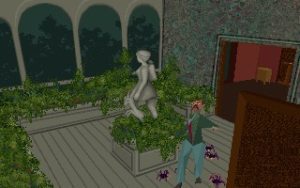 Before the age of 16-bit graphics, atmosphere was really created in the form of text, describing the world around you, much like in a good novel. As graphics and sound pushed on to the next level though, this started to change, with games using lighting, eerie music and unsettling locations to scare the player. This was exemplified perfectly by 1992’s Alone in the Dark. The game cast the player as a private investigator, Edward Carnby in a world inspired by the writing of HP Lovecraft. His task was to investigate a haunted house and, in particular, a piano in the attic. What made the game stand out so much was that it was one of the first games to use polygonal 3D models, and the lighting effects that go with it. There were times, playing this game, where a player’s hands would be trembling as they clicked to open the next door. The game spawned numerous sequels, as well as movie and comic book adaptations, though none had quite the impact of the first game.
Before the age of 16-bit graphics, atmosphere was really created in the form of text, describing the world around you, much like in a good novel. As graphics and sound pushed on to the next level though, this started to change, with games using lighting, eerie music and unsettling locations to scare the player. This was exemplified perfectly by 1992’s Alone in the Dark. The game cast the player as a private investigator, Edward Carnby in a world inspired by the writing of HP Lovecraft. His task was to investigate a haunted house and, in particular, a piano in the attic. What made the game stand out so much was that it was one of the first games to use polygonal 3D models, and the lighting effects that go with it. There were times, playing this game, where a player’s hands would be trembling as they clicked to open the next door. The game spawned numerous sequels, as well as movie and comic book adaptations, though none had quite the impact of the first game.
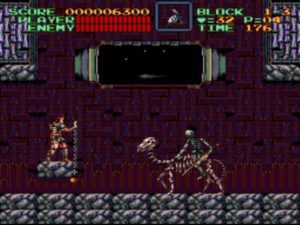 A year earlier, on Nintendo’s SNES console, the release of Konami’s Super Castlevania IV had prompted similar fanfare over its use of atmosphere owing in no small part to the use of a dynamic music score. While the game also showcased Nintendo’s new Mode 7 graphics technology to super-impose 2D sprites on top of 3D backgrounds to add depth to scenery, it was the music which really made this title stand out. The game made full use of what Nintendo at the time described as CD quality sound. In reality it was a bit below what CD audio can produce, but the fact that the score was composed in layers meant that, as certain events and obstacles appeared in any given level, an additional layer of music could be added or subtracted to create the kind of dynamic score that was only previously heard of in film, adding to the suspense or magnifying a climactic moment. The soundtrack was so successful that it was included as a gift with a series of later Castlevania titles and the game firmly cemented its place as a SNES classic.
A year earlier, on Nintendo’s SNES console, the release of Konami’s Super Castlevania IV had prompted similar fanfare over its use of atmosphere owing in no small part to the use of a dynamic music score. While the game also showcased Nintendo’s new Mode 7 graphics technology to super-impose 2D sprites on top of 3D backgrounds to add depth to scenery, it was the music which really made this title stand out. The game made full use of what Nintendo at the time described as CD quality sound. In reality it was a bit below what CD audio can produce, but the fact that the score was composed in layers meant that, as certain events and obstacles appeared in any given level, an additional layer of music could be added or subtracted to create the kind of dynamic score that was only previously heard of in film, adding to the suspense or magnifying a climactic moment. The soundtrack was so successful that it was included as a gift with a series of later Castlevania titles and the game firmly cemented its place as a SNES classic.
Unleashing Hell
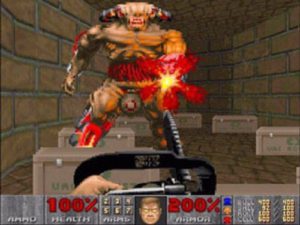 Nowadays, of course, first person shooters are utterly ubiquitous. It’s highly appropriate then, that the latest such game to create a real buzz in the gaming community is the reboot of Doom. What many of today’s gamers perhaps don’t realise is that the original Doom first reared its grotesque head some twenty-three years ago. Hot on the heels of the ground-breaking World War II nazi killing Wolfenstein, Id Software released Doom in 1993. The setting was a futuristic base on Mars, where covert experiments on teleportation between the planet’s two moons had been taking place. Naturally, it all went wrong and opened a trans-dimensional gateway to Hell, unleashing all manner of demonic entities on to the base. They wasted no time in killing or possessing everyone they came into contact with, with the player set as a single marine and, alarmingly, mankind’s only hope. What made the game so frightening in its day was the frantic pace, along with the volume and vile nature of the beasts the player set out to kill. Doom was the first mass market first person shooter as well as the first game to allow the player to butcher his enemies with a chainsaw. To say it was a seminal title is to downplay the impact that it had on future games.
Nowadays, of course, first person shooters are utterly ubiquitous. It’s highly appropriate then, that the latest such game to create a real buzz in the gaming community is the reboot of Doom. What many of today’s gamers perhaps don’t realise is that the original Doom first reared its grotesque head some twenty-three years ago. Hot on the heels of the ground-breaking World War II nazi killing Wolfenstein, Id Software released Doom in 1993. The setting was a futuristic base on Mars, where covert experiments on teleportation between the planet’s two moons had been taking place. Naturally, it all went wrong and opened a trans-dimensional gateway to Hell, unleashing all manner of demonic entities on to the base. They wasted no time in killing or possessing everyone they came into contact with, with the player set as a single marine and, alarmingly, mankind’s only hope. What made the game so frightening in its day was the frantic pace, along with the volume and vile nature of the beasts the player set out to kill. Doom was the first mass market first person shooter as well as the first game to allow the player to butcher his enemies with a chainsaw. To say it was a seminal title is to downplay the impact that it had on future games.
Blood and Guts
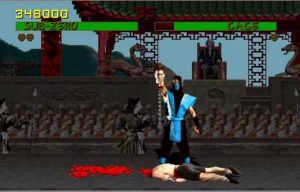 While video games had been a favourite of pro-censorship campaigners for some time by the end of the 1980s, it wasn’t until 1993 that the majority of people really believed they had anything to complain about. Then the now-defunct Midway Games ported the previous year’s arcade hit, Mortal Kombat, to home consoles. What Mortal Kombat lacked in elegance and fluidity of play, it more than made up for in the brutality of its violence. Slapped with an eighteen certificate by the British Board of Film Classification on release, the game featured digitised sprites–the closest thing to photorealism in video games at the time–and involved a lot of fantastical characters, fighting to the death and rewarded for the performance of ‘fatality’ moves. These ranged from the comic roundhouse kick beheading of Johnny Cage to the visceral ripping off of an opponent’s head (complete with blood-dripping spinal column) by Sub Zero. What the censors failed to realise and fans of the game seized on very quickly was precisely that it was over the top, ludicrous, even camp. This has been a feature that has only grown as Mortal Kombat has spawned a whole library of sequels and spin-offs. Though some of the graphical touches looked realistic in the sense that real actors had played their parts, there was no denying that the entire series was deliberately tongue in cheek. Inevitably, the negative publicity only served to increase sales. Another great controversy over Mortal Kombat was when Nintendo granted a license for the SNES conversion only if all traces of blood were removed from the game. This resulted in something of an outcry from disappointed fans and, as will be shown in the next, final part of this series, they sought to avoid such actions in the future.
While video games had been a favourite of pro-censorship campaigners for some time by the end of the 1980s, it wasn’t until 1993 that the majority of people really believed they had anything to complain about. Then the now-defunct Midway Games ported the previous year’s arcade hit, Mortal Kombat, to home consoles. What Mortal Kombat lacked in elegance and fluidity of play, it more than made up for in the brutality of its violence. Slapped with an eighteen certificate by the British Board of Film Classification on release, the game featured digitised sprites–the closest thing to photorealism in video games at the time–and involved a lot of fantastical characters, fighting to the death and rewarded for the performance of ‘fatality’ moves. These ranged from the comic roundhouse kick beheading of Johnny Cage to the visceral ripping off of an opponent’s head (complete with blood-dripping spinal column) by Sub Zero. What the censors failed to realise and fans of the game seized on very quickly was precisely that it was over the top, ludicrous, even camp. This has been a feature that has only grown as Mortal Kombat has spawned a whole library of sequels and spin-offs. Though some of the graphical touches looked realistic in the sense that real actors had played their parts, there was no denying that the entire series was deliberately tongue in cheek. Inevitably, the negative publicity only served to increase sales. Another great controversy over Mortal Kombat was when Nintendo granted a license for the SNES conversion only if all traces of blood were removed from the game. This resulted in something of an outcry from disappointed fans and, as will be shown in the next, final part of this series, they sought to avoid such actions in the future.
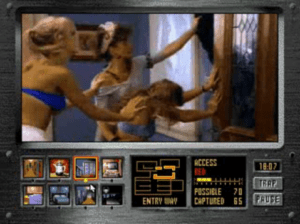 While on the subject of photorealism and controversy in horror gaming, it’s worth mentioning Night Trap. A launch title for the ultimately doomed Panasonic 3DO console, as well as receiving releases on the Sega CD and PC CD-Rom, Night Trap was essentially a live action slasher movie of sorts, where the player had (limited) control over events. A group of college girls were having a sleep over at a house where another group of girls had previously gone missing. The plot line was that the ‘Special Control Attack Team’ (of whom the player was a member) had set up a variety of traps to catch whoever or whatever was kidnapping the girls. The game played out over more than 90 minutes of video, with charts on screen advising the player when a trap ought to be activated. The game received mixed reviews, with some declaring it a masterpiece and others pointing to the lack of real control the player has over the events of the game. It sold reasonably well until a seemingly organised complaints campaign whipped up mass controversy about the game and saw it pulled from shop shelves. The arguments against it were that it encouraged the capture and harm of young women and also over particular scenes with one actress in a nightgown while being attacked. In spite of all this, it’s fair to say that Night Trap made a strong impression on the gaming world of its time and rumours abound of a modern adaptation even now.
While on the subject of photorealism and controversy in horror gaming, it’s worth mentioning Night Trap. A launch title for the ultimately doomed Panasonic 3DO console, as well as receiving releases on the Sega CD and PC CD-Rom, Night Trap was essentially a live action slasher movie of sorts, where the player had (limited) control over events. A group of college girls were having a sleep over at a house where another group of girls had previously gone missing. The plot line was that the ‘Special Control Attack Team’ (of whom the player was a member) had set up a variety of traps to catch whoever or whatever was kidnapping the girls. The game played out over more than 90 minutes of video, with charts on screen advising the player when a trap ought to be activated. The game received mixed reviews, with some declaring it a masterpiece and others pointing to the lack of real control the player has over the events of the game. It sold reasonably well until a seemingly organised complaints campaign whipped up mass controversy about the game and saw it pulled from shop shelves. The arguments against it were that it encouraged the capture and harm of young women and also over particular scenes with one actress in a nightgown while being attacked. In spite of all this, it’s fair to say that Night Trap made a strong impression on the gaming world of its time and rumours abound of a modern adaptation even now.
In the final part of this series, This is Horror will look back at the origins of today’s horror masterpieces, and the impact the first instalments of Resident Evil & Silent Hill had on gaming as a whole, as well as a few other classic titles from the 32 and 64-Bit console generations that today’s gamers might have missed.
KEV HARRISON









